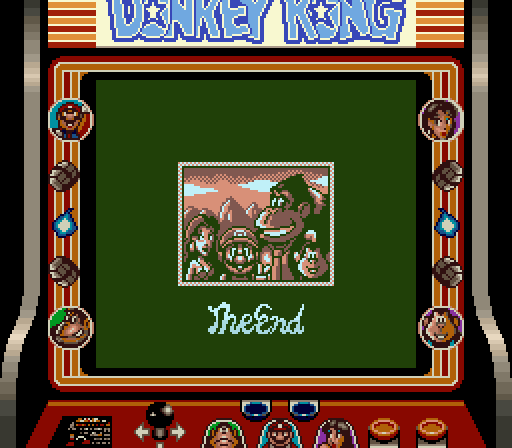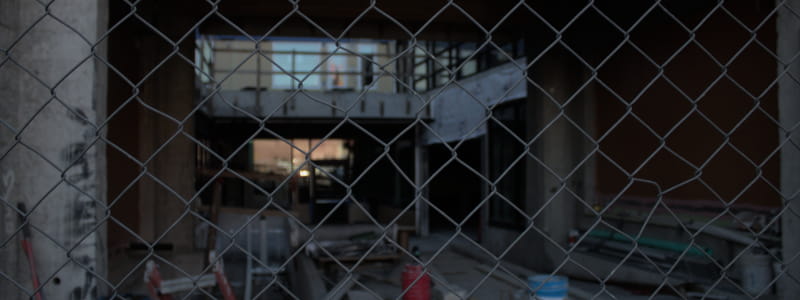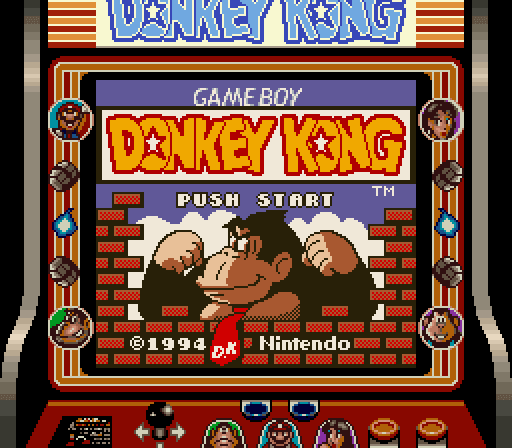
¿Remember when I started that GBC tribute thing 2 years ago, which I didn’t finish, & I promised to do 1 for the original Game Boy, which I ne’er got to @ all? Well, it turned out I didn’t have much to say ’bout many o’ the games I listed. As it turned out, promising to write ’bout Pokémon Gold & Silver when I already wrote an article ’bout the whole Pokémon series was just asking for writer’s block. So I let it fall to the wayside & realized that doing these system-based tributes just ’cause the system happened to have existed for a multiple o’ 10 years ( tho that’s better than a multiple o’ 5, like something as arbitrary as 35, which is certainly a dumb milestone to make a half-assed battle royale game & e’en-mo’-half-assed port o’ 3 games based on your series ).
But something had been biting on my conscience: I can’t not talk ’bout Game Boy Donkey Kong. I mean, yeah, I don’t need to talk ’bout Pokémon Special Pikachu Version — O wait, I already did. Well, I don’t need to talk ’bout Pac-Man: Special Color Edition — Actually, that had a pretty cool puzzle mode I ought to show off. Anyway, I don’t need to talk ’bout Donkey Kong Country on the Game Boy Color — Actually, that would be interesting to look @.
Well, fuck it, we’ll talk ’bout those games later, e’en if the Game Boy or Game Boy Color’s age is a prime #. For now we talk ’bout Game Boy Donkey Kong, or “Donkey Kong ’94”, as people used to call it, for some reason. The game itself was just called “Donkey Kong” on marketing material, including the box, showing that Nintendo had come up with the dumbass idea o’ naming a sequel the same as the much-mo’-famous original, only for nobody to call the new game by that title, just like nobody would be daff ’nough to call shit like Sonic 06 or SimCity 5/2013 just Sonic the Hedgehog or SimCity. Anyway, the title screen o’ this game says “Game Boy Donkey Kong”, so that’s what I’m going to call it, or “GBDK”, like a Linux programmer would title it.
I don’t know how knowledgeable the average player was ’bout what kind o’ game GBDK was @ the time it came out, since I was 2 @ the time, but I knew nothing ’bout it when I 1st started playing it, since I received the game as a Christmas gift from some local church none o’ our heathen family attended after my older brother tricked them into thinking we were poor ( we were a year off from that happening ). Thus, I went into the game thinking ’twas just a port o’ the classic Donkey Kong arcade game & that I wouldn’t like it since the Donkey Kong arcade game is rather hard & as a kid I had this strange idea that if I sucked @ a game it wasn’t a fun game. When I 1st played the game & played thru the familiar levels jumping o’er barrels on girders, riding elevators & dodging… ¿bouncing springs? I don’t know what the hell Donkey Kong is throwing in that level. Anyway, I was surprised to find that ’twas a lot easier than I remembered ( I now know that’s ’cause Mario’s jumping is much improved, making it much easier to clear obstacles, & the game gives you much mo’ lenience in terms o’ how far you can fall before you crack your skull & die ).
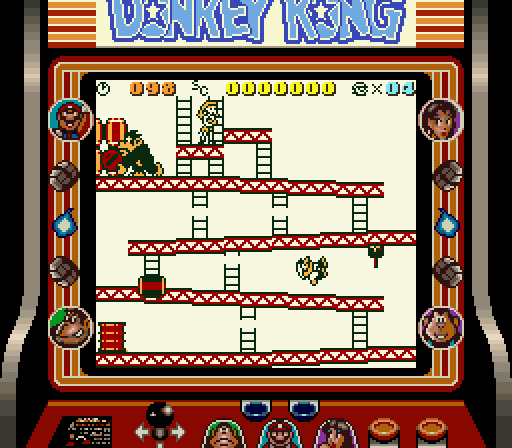
But the real surprise came after soon beating the 4th level wherein you pull out all the pegs, causing the structure Donkey Kong’s standing on to collapse & Donkey Kong to fall onto his head while Mario, who is on the same structure, magically warps to the sides in safety.
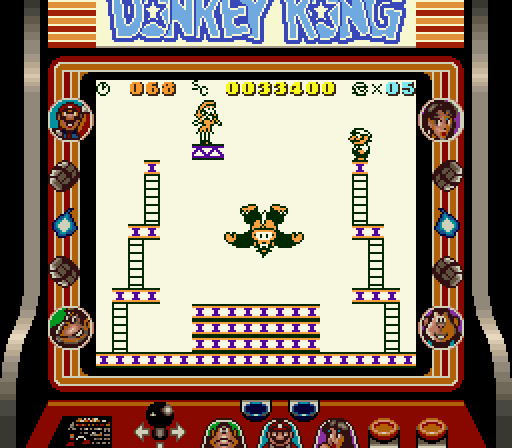
I expected the game to be o’er & to turn the game off & find something else to do, only to see Donkey Kong get up, slam down so hard that the girders Mario & Pauline were standing on collapsed, causing them to fall, grab Pauline, & start running to the right while this wicked riff starts playing:
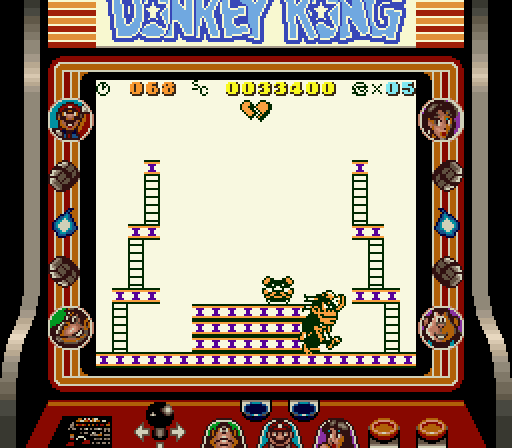
Mario — who somehow immediately recovers from falling on his head, e’en tho that’s death in the game proper — chases after them into a new screen showing them entering the city, where the game shows you the new mechanic the rest o’ the game will revolve round: Donkey Kong locks himself ’hind a locked door, only for a key to conveniently fall from the sky, which Mario needs to grab & bring to the locked door.
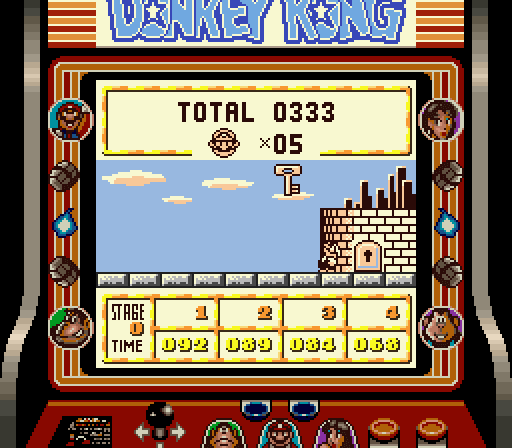
& thus what might’ve been yet ’nother port o’ the 4-level classic Donkey Kong arcade game ( not to sling hate @ said classic itself, which is 1 o’ the best arcade games o’ the golden age ) evolves into a puzzle platformer thru 100 cleverly-designed levels where you have to figure out how to get to the key & bring it to the locked door.
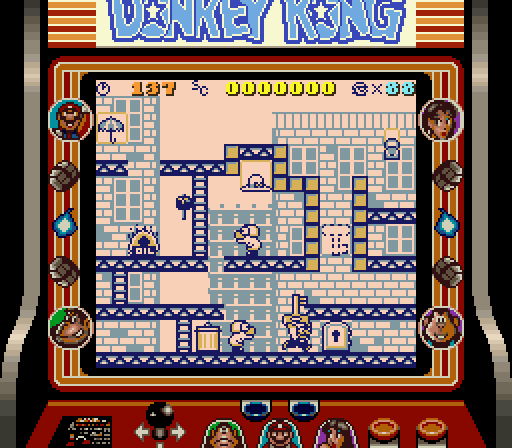
’Long the way you can also collect Pauline’s hat, parasol, & purse: if you collect them all you can play a minigame to win extra lives… which isn’t all that useful, since the game just throws lives @ you. To give you an example: when you beat a boss the game gives you a life for every 100 points you collected, as well as 1 mo’ life for whate’er remainder you have ( they effectively round up to the next 100 ). I don’t e’en think Donkey Kong Country Returns or New Super Mario Bros. games are that generous.
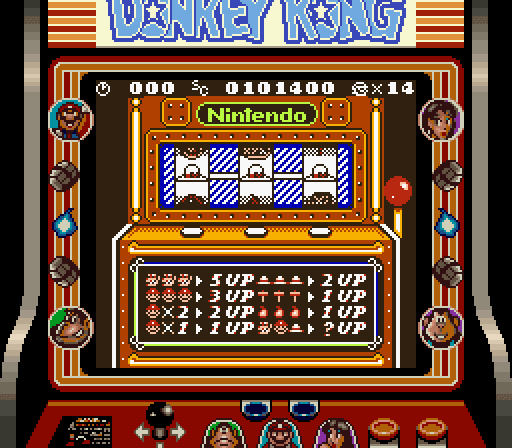
The most notable improvement this game had o’er the arcade original are the controls, which feel mo’ fluid, mo’ in line with contemporary games, than the original arcade game’s, which, while better than any platformer till Super Mario Bros. came out, felt stiff in comparison to Super Mario Bros. & onward platformers. But Mario didn’t only feel smoother, but could do far mo’ — e’en mo’ than in Super Mario Bros. 3 or Super Mario World. 2 years before Super Mario 64 popularized such movement for Mario, Mario learned how to double & triple jump, side-flip, & backflip, as well as do a hand-stand, which helps Mario block falling obstacles from squishing him &, in the case o’ barrels, allows him to pick them up & use them as a weapon for himself. The only limitation is that Mario can’t do this while holding anything, including the key.
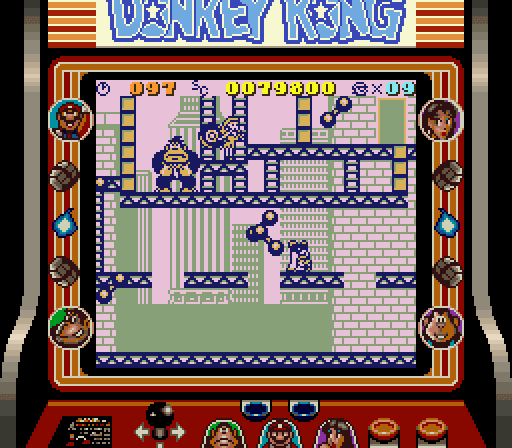
Unfortunately, something this game has in common with both the classic arcade Donkey Kong & Super Mario 64 is taking damage by falling too great a height. Howe’er, unlike classic Donkey Kong, Mario has to fall far mo’ than just his own height to end up rolling all the way round & cracking his skull; falling only a few blocks down, ’stead, causes him to roll, stunning him & causing him to slip a bit, but otherwise not harming him — so long as he doesn’t roll into something else that does, that is.
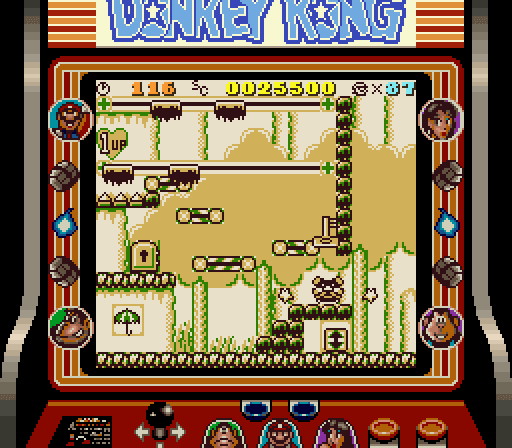
In addition to Mario’s upgraded gymnastic abilities, GBDK offers plenty o’ tools to manipulate levels. Taking inspiration from the Super Mario Bros. 2 released for the US, you can jump on many enemies, pick them up, & throw them as weapons, just like the key. Holding something also gives Mario an extra hit, causing him to bounce back & drop whate’er he’s holding if hit, rather than die — tho if Mario gets stunned back into ’nother danger, he’ll die to that ’stead.

This game also has switches you can flip in either direction to open & close doors or change the direction o’ conveyor belts & timed items that change the level, such as blocks, springs, ladders that grow upward like vines in regular Mario games, & bridges that spread out horizontally till it hits something else solid.
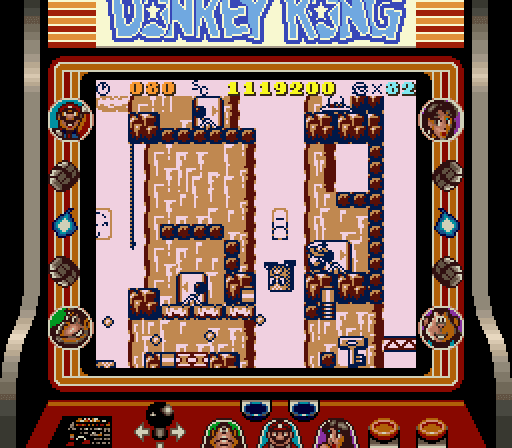
GBDK has generally mo’ interesting level themes than the average Mario game, tho perhaps not as exotic as the smaller selection in its sequel, Mario vs. Donkey Kong. Rather than starting @ generic “Green Grassland Zone”, the 1st world is the relatively mo’ exotic city. While most o’ the themes are common, like the forest, jungle, desert, & maybe iceberg & rocky-valley worlds, some are rare, like the ship world, & I don’t think I’ve seen ’nother platformer with an airplane theme.
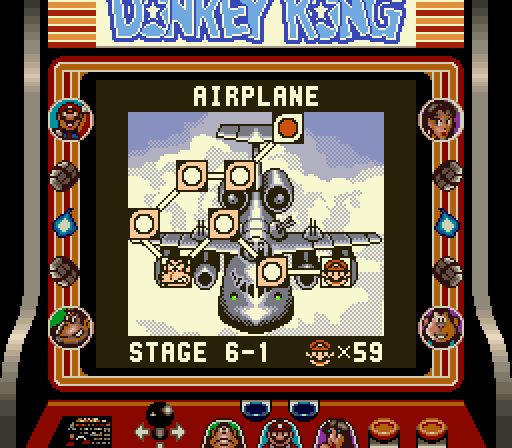
These themes are not only visual, but also affect what gimmicks they introduce or use. For instance, the forest & jungle worlds introduce mechanics from Donkey Kong Jr., such as climbable vines & claptraps & e’en feature DK Jr. helping his father during boss battles, as well as birds that fly round trying to drop killer eggs on your head & seed-spitting plants; the ship world introduces scaffolding that you can use to fling you up & ’way & enemies that shove you round & can help or hurt you by pushing you under small crevices you have to duck under ( you can’t walk or jump while ducking ) or smashing you to death gainst a wall, which I definitely didn’t steal in Boskeopolis Land’s “Pepperoncini Pyramid” level; the desert levels introduce blocks that can be broken with the hammer; the iceberg world features blocks that can only be melted by walking fire enemies, iceberg platforms that float on water, & falling icicles; & the airplane theme features wind. While the penultimate world, the “Rocky-Valley” world, doesn’t have much in the way o’ an interesting theme or many interesting gimmicks, — other than maybe waterfalls that are slow to swim up & lava in 1 level — this long, grueling world is full o’ the trickiest puzzle levels, while the final world, the “Tower”, makes every level a boss battle gainst DK.
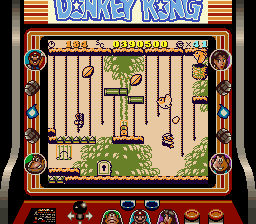
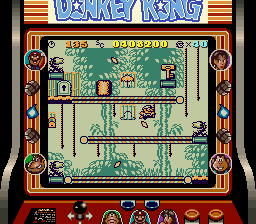
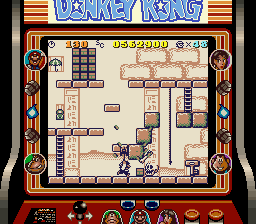
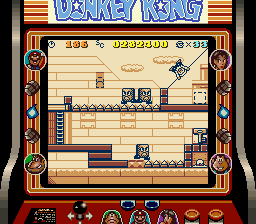
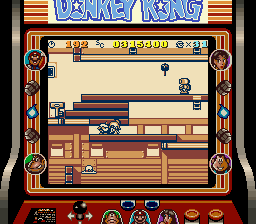
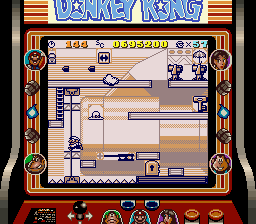
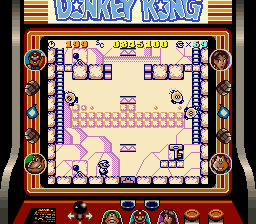
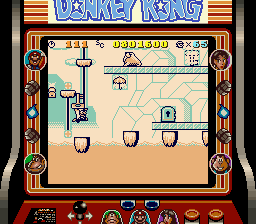
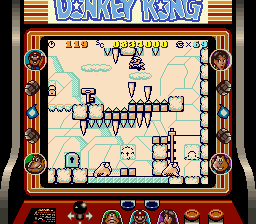
The game e’en adds a twist to the locked door on some levels, adding extra fake doors on some levels & making the locked door invisible on others, challenging the player to pay attention as the level starts to see where Pauline’s “HELP!” bubble appears to find it.
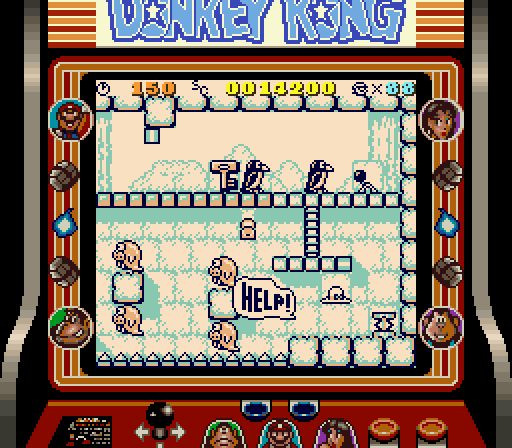
Every 4th level has you fight gainst DK, with most challenging you to reach DK while the last level o’ each world has you pick up items — usually barrels — to throw @ DK. The 1 exception is the 5th level o’ the final world, which challenges you to raise all the keys on chains to all the locks, locking DK Jr. up — a callback to the last level o’ the arcade Donkey Kong Jr.
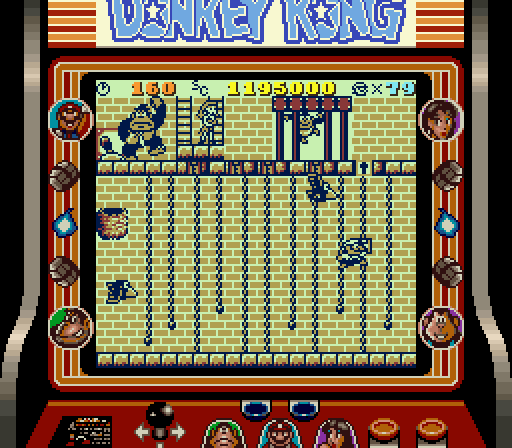
Graphics
I think this game was specially made for the Super Game Boy so it looks very nice on the Super Game Boy, with duotone palettes for levels & map screens with so many colors, they look like they come from a Game Boy Color. Strangely, I don’t remember if ’twas this colorful on the Game Boy Color, e’en tho that was how I played the game as a kid.
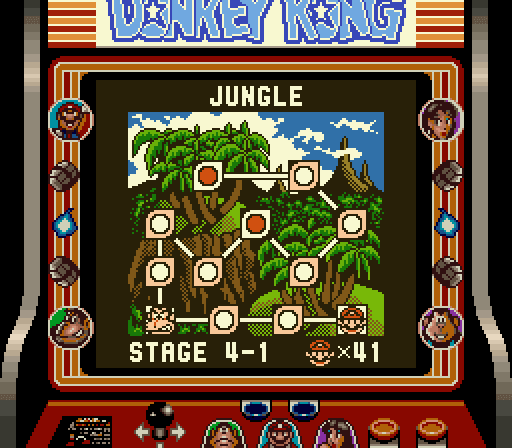
What I do know is that the virtual console version sucks dick ’cause for no good reason whatsoe’er Nintendo made it grayscale, so I’d avoid that version. If you don’t want to pay the $15-$20 it costs to buy the game off eBay — much less buy a Game Boy Color or Super Game Boy & Super Nintendo — or be a scurvy pirate, just buy the game off virtual console & then download a rom & play on an actually good emulator. Nintendo got their money on a game they developed decades ago, which they wouldn’t get if you bought a hard copy used, & you got a superior version o’ the game — everyone wins.
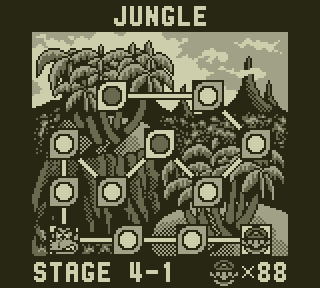
Music
The 1 song everyone talks ’bout from this game is the 1st final boss theme, commonly called “Final Showdown”, for some reason. The reason why everyone talks ’bout it is obvious: it’s probably the longest loop for a game where the average song loop length is ’bout 15 seconds, making it stand out as less repetitive & mo’ interesting.
Still, that’s not to say none o’ the other music is good. For instance, the 2nd final boss — technically the real final boss — which heavily remixes the music that plays when you enter a DK level is properly menacing. The miniboss theme for DK levels that aren’t the last o’ the world, too. Ironically, the end-o’-world boss theme is much jauntier, tho I certainly find it catchy.
Actually, I like a lot o’ the menacing songs in this game, such as the iceberg & jungle world map music.
Finally, the 7th level theme, oft called “Airplane Overworld” ( e’en tho the map is usually considered the o’erworld, for some reason many people consider the o’erworld to be the part that isn’t the map for this game ), slaps my dick off. Please give me medical assistance.
Conclusion
I said in my article ’bout the sequel, Mario vs. Donkey Kong, that I preferred this game to it, but the 2 are close, & it depends on my mood. This game has tighter controls, has mo’ refined gameplay without the lame escort mission nonsense, & has much better music. Still, Mario vs. Donkey Kong does have some advantages, such as having mo’ interesting level themes, having mo’ levels, & having mo’ meaningful challenges to accomplish in addition to beating every level. Mario vs. Donkey Kong had presents & a high score for each level to beat to get a star & unlock extra stages, offering much mo’ replay value, while this game is so straightforward & not that hard that a good player could probably beat it in a day.
I’m actually mixed on which has better level design. It seems GBDK has mo’ gimmick variety ( & just ’bout every mechanic in Mario vs. Donkey Kong that isn’t the colored switches & blocks is from GBDK ), while Mario vs. Donkey Kong was able to form mo’ complex levels while relying mo’ heavily on the red, blue, & yellow switches & blocks.
